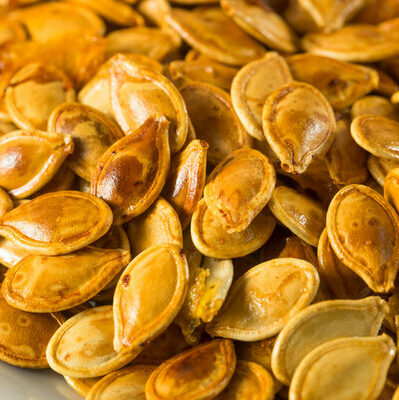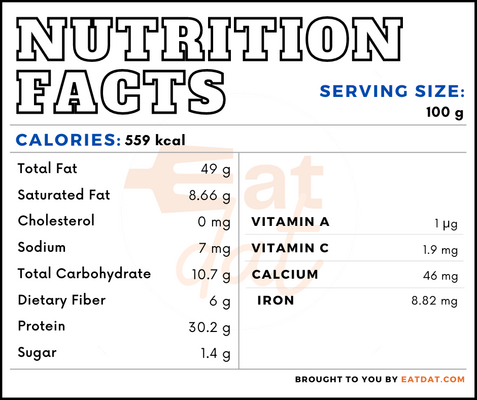
Pumpkin Seeds
also known as Pepitas
What are Pumpkin Seeds?
Pumpkin seeds are the seeds found inside pumpkins. These edible seeds are larger than many other seeds and have a olive green color inside the white inedible husk. They have a crunchy texture and a nutty flavor and are often consumed roasted and salted. Also, they may be used for making smoothies, breads, cereals, and energy bars, as well as topping for a variety of dishes.
- These seeds are an integral part of Mexican cuisine.
- In addition, they are common in other countries in the Americas.
The top 10 most popular pumpkin seed brands include:
- Terrasoul Superfoods
- Anthony’s
- Go Raw
- Wilderness Poets
- Good Sense
- Eden
- Harvested For You
- Now Foods
- Yupik
- Whole Foods Market
Origin of pumpkin seeds
Pumpkins most likely originated in Mexico. There have been archaeological discoveries of pumpkin seeds in the city of Oaxaca. These pumpkins date back 7,500 years and were small, hard, and bitter. Pumpkins were the first crops ever grown in North America but were originally used for the flesh instead of the seeds.
Nutrition
Nutritional profile for pumpkin seeds (100 g):

Pumpkin seeds are rich in magnesium, phosphorous, and potassium. Also, they contain calcium, iron, sodium, manganese, selenium, niacin, folate, choline, carotene, vitamin A, lutein + zeaxanthin, tocopherol, vitamin K, and essential fatty acids in decent amounts. Regular consumption of pumpkin seeds may help in reducing the risk of hypertension, hypercholesterolemia, and arthritis. Additionally, they help reduce the risk of diabetes and have anti-inflammatory properties.
Commercial production
The top pumpkin consuming and producing countries in the world are China, India, Russia, Ukraine, and the USA. Around 26,522,472 tons of pumpkin are produced every year.
Pumpkins grown for their seeds are of a different variety than those grown for their flesh. As a warm-season crop, they grow best in rich and well-drained soils with mild acidity. These pumpkins require plenty of space because the vines like to spread out. Furthermore, they must be harvested only when they are fully mature and their skin has hardened and the color turns deep orange. Then, the seeds are removed and dried before being roasted and packaged.
Pumpkin seeds must first be dehydrated or sun-dried. Then, they are cooled and stored in an airtight container.
Pumpkin seed recipes
These seeds are usually consumed roasted and salted. However, a variety of dishes can be prepared using these seeds. Here are a few recipes to try:
- Roasted Pumpkin Seeds
- Cookies
- Pepita Salsa
- Pumpkin Seed Enchiladas
- Pipián Verde
- Sikil P’aak
- Chimichurri
- Pesto Rolls
- Sunflower Pumpkin Loaf
- Pumpkin Cheesecake Truffles
- Posole
- Pumpkin Seed Oil Cake
FDA regulations
There is no current standard of identity for pumpkin seeds. However, the FDA does allow certain varieties of squash seeds to be labeled as pumpkin seeds on food labels.
References
Abuelgassim, Abuelgassim O, and Showayman I A Al-showayman. “The effect of pumpkin (Cucurbita pepo L) seeds and L-arginine supplementation on serum lipid concentrations in atherogenic rats.” African journal of traditional, complementary, and alternative medicines: AJTCAM vol. 9,1 131-7. 2 Oct. 2011, doi:10.4314/ajtcam.v9i1.18, https://www.ncbi.nlm.nih.gov/pmc/articles/PMC3746528/
Paul, Mollika et al. “Pumpkin (Cucurbita maxima) seeds protect against formaldehyde-induced major organ damages.” Heliyon vol. 6,8 e04587. 20 Aug. 2020, doi:10.1016/j.heliyon.2020.e04587, https://www.ncbi.nlm.nih.gov/pmc/articles/PMC7452453/
Tori Avey, History of Pumpkins and Recipe Round-Up, The History Kitchen, https://www.pbs.org/food/the-history-kitchen/history-pumpkins-recipes
